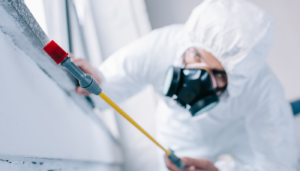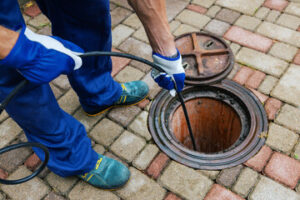Pest Control Shawnee KS seeks to reduce the level of damage a pest causes to an acceptable level. This involves prevention, suppression and eradication.
Barriers and exclusion methods block the way for pests – such as rodents and roaches – to get where they’re not wanted. Door sweeps prevent mice and roaches from entering homes, while sprays create chemical boundaries against insects.

The best way to keep pests from pestering your business is prevention. This involves preventing the development of an infestation by removing a pest’s food, water and shelter. Denying these elements to a pest can make it impossible for them to survive or reproduce, and is the only true way of keeping pests from infesting your property at all. Eliminate puddles and other unnecessary water sources, prune and maintain trees and shrubs to remove food (such as berries) and roosting sites, clean up spilled ingredients to deny them shelter and eliminate their hiding places, and keep trash receptacles closed to prevent pests from accessing them. A gravel-or other hard-surfaced-barrier next to a building’s exterior walls can help prevent pests from hiding behind them, and keeping grass and weeds cut can make it difficult for them to hide beneath them.
Pests are not just unpleasant to have around; they can cause deeper sanitary problems and even damage product, equipment and facilities. Some are also dangerous to human health and can carry pathogens that can be spread to others through contact with contaminated surfaces.
Integrated pest management (IPM) is an effective and environmentally sound approach to controlling pests. It emphasizes inspections, monitoring and corrective action to reduce the use of pesticides in and around a facility. It is most commonly used in commercial and institutional settings, such as hospitals, schools, offices, and food processing and storage plants.
Physical control methods include screens, netting and a variety of traps. Physical barriers, such as obstructive landscaping and crop planting that deters pests, are also used. Chemical pest control uses a wide range of chemicals that target different aspects of pests, such as their nervous systems, metabolism or reproductive capabilities. These may also be used as a diversionary element to draw pests away from a desired area, for example placing a woodpile close to crops and then spraying them with a pesticide.
Biological pest control uses natural enemies of the pest, such as parasites, predators, and pathogens. It can also involve the release of sterile insects or pheromones to interfere with normal insect growth. Biological pest control rarely achieves eradication, and the degree of success fluctuates.
Suppression
If pests are already present and causing damage, the goal of pest control is to reduce their numbers to an acceptable level. Suppression methods include physical controls such as traps and bait stations; mechanical controls such as screens, barriers, and fences; and changes to the environment such as lighting, heat, radiation, or electricity.
A variety of natural enemies also help suppress pests, including predatory birds, mammals, and amphibians; parasitic insects, mites, nematodes, and fungi; and pathogens that cause diseases in plants or animals. The effects of weather on pest populations are important, as well. Rain and cool temperatures can kill pests or cause them to move elsewhere in search of food.
The first step in a successful integrated pest management (IPM) plan is to determine which control measures are appropriate for each pest situation. To do this, a thorough examination of the pest is made, including studying its life cycle, possible damage, and natural enemies. In addition, a careful assessment of the environment is made, especially examining climate, soil conditions, and other factors that influence the growth and behavior of the pest.
Chemicals can be used to prevent or eradicate pests in homes and businesses, but should only be used by those trained and licensed to do so. Using the right amount of chemical in the correct way and at the right time can limit the amount of exposure to humans and pets.
Physical pest control methods include cleaning up clutter to remove places for pests to breed, and caulking cracks and crevices. Eliminating pests’ food sources, such as rotting garbage or compost, and sealing the entry points of a home or business can also help prevent them from breeding inside.
Planting weeds that are toxic to pests and growing crops with resistance to them can also prevent some infestations. Soil enhancing treatments such as adding organic matter, and using beneficial nematodes like Steinernema carpocapsae can also suppress pests. The goal of all physical controls is to provide obstacles for pests and make the environment unwelcoming, so they leave or find it impossible to reproduce.
Eradication
Once pests have been detected, it is important to act quickly. This will prevent the problem from spreading to other parts of your home, and may even save you money in the long run. Start by identifying where they are entering your property – make sure to check behind the fridge, oven and under kitchen sinks – and then remove their food and water sources. You can do this by fixing leaks, blocking holes with caulking and removing rubbish from your property.
Chemical pest control involves the use of solutions such as repellents and insecticides, which kill or deter pests by affecting their nervous systems. This can be a quicker option than biological methods, and provides instant results. However, it is important to consider the effect that chemicals have on the environment and health of humans, as well as their pets and children, when using this type of pest control.
Physical pest control involves the use of traps, netting and decoys, which are designed to keep pests away from specific areas of your property. These are often easy to set and require no ongoing maintenance, but they may not be as effective for larger infestations.
Biological pest control involves the use of natural predators and parasites to control unwanted pests. These are often safer and more environmentally friendly than chemical options, but they may take longer to work. Examples of biological pest control include introducing lacewings to your garden, which will feed on aphids and other soft-bodied insects, or spraying your garden with the microscopic nematode Steinernema carpocapsae, which attacks a wide range of common household pests, including fleas, cockroaches, grubs and ants.
In some cases, it can take up to a month to see results from a pest treatment. For example, cockroaches are particularly resilient and some pesticides need to be re-applied regularly to continue to work. It is also important not to over-treat your property, as this can reduce the effectiveness of residual treatments. If you are unsure of how to treat your pest problem, always seek professional advice. A qualified pest control technician will be able to offer you the best solution for your needs and provide you with a free quote.
Management
Many pests can be controlled through methods that don’t involve chemicals. These include keeping pests out by repairing or sealing cracks and crevices, or using barriers such as fences or walls to keep them away from plants or buildings. Other methods prevent pests from finding food, water or shelter. This can be done by planting species that are less attractive to pests, modifying cultural practices, or adjusting land use patterns.
Physical control methods include trapping, snaring, and netting. Insects, rodents and birds are often targeted. These methods require attention to detail to locate and set the traps, and to regularly check and remove them. They also need to be designed and built to be effective at catching the target animal without harming other animals or the environment.
Chemical controls are the last resort when other methods fail. They can be used to kill existing pests or to prevent them from re-invading as long as the risk is acceptable to those using the area. This is especially important for commercial operations where public health and image concerns may be involved. In general, chemical treatment should be applied only after monitoring indicates that it is needed, and treatments should be made with the goal of minimizing damage to non-target organisms and the environment.
The most desirable way to manage pests is to prevent them from entering a site at all. This is called integrated pest management or IPM. IPM programs employ a variety of prevention tactics, such as planting crops that attract fewer pests or provide a natural barrier, or by removing materials that serve as protective overwintering sites for them.
This type of approach takes into account that all parts of a natural ecosystem are interrelated. For example, water levels and the availability of other resources affect the population growth rates of some insects. And natural enemies, such as birds or other predators, can reduce the size of an undesirable insect population by consuming the eggs and larvae. Natural features, such as mountains or large bodies of water, can restrict the movement of some pests and limit their spread.








